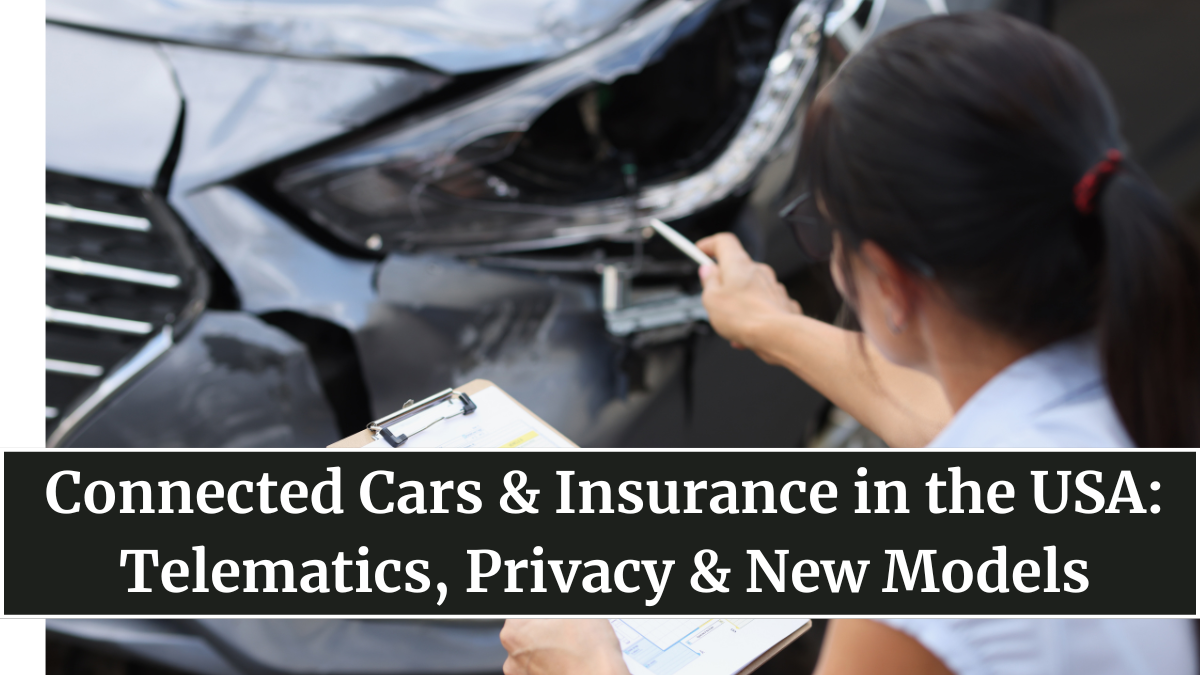Cars are no longer just machines on wheels — they’re data-generating ecosystems. In the United States, the rapid growth of connected vehicles is redefining how drivers are insured, how risks are assessed, and even how accidents are investigated. The integration of telematics and real-time data tracking is giving birth to a new era in auto insurance — one driven by behavior, not assumptions.
As over 60% of new vehicles in 2025 come equipped with connectivity features, insurers are racing to adopt usage-based models that reward safer, data-backed driving.

What Is Telematics and How Does It Work?
Telematics refers to the fusion of telecommunications and informatics. In cars, it uses GPS, onboard sensors, and cloud data to track driving habits such as speed, braking, cornering, and mileage.
This data is then transmitted securely to insurers or fleet operators, who can analyze real-world behavior to offer customized premiums and risk assessments.
Typical telematics features include:
-
Real-time driving analytics
-
Trip history and mileage tracking
-
Crash detection and emergency alerts
-
Vehicle diagnostics and maintenance updates
-
Predictive risk scoring
By shifting from static data (age, ZIP code, credit score) to dynamic data (actual driving behavior), telematics insurance brings greater fairness and transparency to U.S. motorists.
The Rise of Usage-Based Insurance (UBI)
Telematics has led to the explosion of Usage-Based Insurance (UBI) programs across the United States. Instead of paying flat-rate premiums, drivers now pay based on how they drive.
Common UBI models include:
| Type | Description | Key Benefit |
|---|---|---|
| Pay-How-You-Drive (PHYD) | Monitors driving style — braking, speed, and acceleration. | Rewards safe drivers with lower premiums. |
| Pay-As-You-Drive (PAYD) | Charges insurance based on total mileage. | Best for low-mileage drivers. |
| Manage-How-You-Drive (MHYD) | Combines PHYD with proactive driving feedback via app alerts. | Helps improve long-term driving behavior. |
Leading insurers like Progressive (Snapshot), Allstate (Drivewise), and State Farm (Drive Safe & Save) are integrating telematics directly into their mobile apps and connected vehicles.
Benefits of Telematics for Insurers and Drivers
Both sides of the insurance ecosystem stand to gain from this digital revolution:
For Insurers:
-
Real-time claim validation and faster processing.
-
Lower fraud cases through verified data.
-
Enhanced risk profiling for more accurate pricing.
For Drivers:
-
Discounts of up to 40% for safe driving.
-
Personalized feedback to improve driving habits.
-
Quick roadside assistance and emergency response.
This symbiotic system ensures fairer premiums while improving safety and accountability on American roads.
Data Privacy: The Double-Edged Sword
With every innovation comes new concern — and for connected cars, it’s data privacy.
Telematics systems collect sensitive information such as location, travel routes, and even in-vehicle communication logs. This raises key questions: Who owns this data — the driver, the insurer, or the automaker?
Privacy experts warn that without proper regulation, driver data could be used for marketing, surveillance, or even legal disputes.
To address this, several U.S. states are implementing new policies under consumer privacy acts, ensuring transparency, user consent, and secure data storage. Automakers are also introducing “data opt-out” options, allowing users to control how their telematics data is shared.
How Automakers Are Integrating Insurance
Automotive brands are no longer bystanders — they’re becoming active participants in the insurance industry.
Companies like Tesla, GM, and Ford are offering built-in insurance programs powered by telematics data directly from vehicles. Tesla’s model, for instance, tracks real-time “safety scores” to adjust premiums monthly.
Benefits of automaker-led insurance models:
-
Instant claim resolution with verified data logs.
-
Lower premium fluctuation due to continuous monitoring.
-
Integration of insurance within the car’s infotainment or mobile app ecosystem.
This seamless approach bridges the gap between ownership, driving, and protection, setting the stage for the next generation of insurance.
The Future of Telematics Insurance in the U.S.
By 2030, connected car insurance is expected to account for over 70% of all new auto policies in the U.S. The integration of AI, machine learning, and edge computing will further enhance predictive analytics, allowing insurers to preemptively manage risks.
Emerging trends shaping the next decade include:
-
AI-powered accident reconstruction for instant claims.
-
Blockchain-backed data ownership models for transparency.
-
Cross-brand data standardization between automakers and insurers.
-
Cyber insurance add-ons protecting vehicles against hacking threats.
As cars become smarter, insurance is becoming more personalized, precise, and digital-first — transforming not just how we drive, but how we’re protected.
FAQs
What is telematics in car insurance?
Telematics involves using sensors and GPS technology to monitor driving behavior and mileage, helping insurers offer customized premiums.
Which companies offer telematics-based insurance in the U.S.?
Progressive, Allstate, State Farm, Tesla, and Nationwide are among the leading insurers using telematics programs.
Is my driving data shared with third parties?
Most insurers and automakers are required to disclose data-sharing policies. Users can typically opt out of sharing non-essential data.
Do telematics systems reduce premiums?
Yes, safe drivers often receive discounts of up to 40% for maintaining good driving behavior over time.
What’s the future of connected car insurance?
Expect fully automated claim processing, predictive risk analytics, and seamless insurance integration within vehicles by 2030.
Click here to know more.
